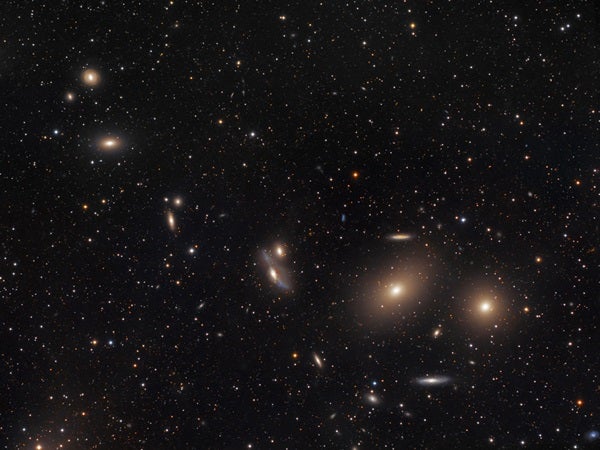Q: Do orbital motions between galaxies affect calculations of the cosmological redshift?
A:Yes, they do. The observed redshift, or wavelength shift due to motion, of a galaxy’s characteristic light spectrum is a combination of the galaxy’s motion with respect to its neighbors (“peculiar velocity”) and the expansion of the universe (“cosmological redshift”). The latter only corresponds to objects moving away from us — their light shifts to the red end of the electromagnetic spectrum.
In less crowded regions (where there are few galaxies), peculiar velocities can be about 60 miles per second (100 kilometers/second), while in clusters of galaxies — which are much more densely packed — they can be more than 600 miles/s (1,000 km/s). A peculiar velocity of 600 miles/s (1,000 km/s) will lengthen or shorten the wavelength of light by a factor of 1.0033.
A cosmological redshift will lengthen the wavelength by a factor that depends on the distance between the telescope and the galaxy. A redshift of 0.01 means a lengthening factor of 1.01.
For galaxies at large distances from us, the cosmological redshift’s effect is much larger, which means the peculiar velocities are small in comparison. Galaxies within about 150 million light-years (a small distance for cosmologists), however, correspond to cosmological redshifts less than 0.01, so peculiar velocities at these distances are significant. For example, the Virgo cluster holds galaxies showing wavelength shifts corresponding to factors of 1 (i.e., no shift) to 1.008, yet we know that most of them are in the cluster and have a similar cosmological redshift of 0.004. The range results because galaxies in the cluster can have peculiar velocities up to 750 miles/s (1,200 km/s): either toward us, which can cancel out the effect of the cosmological redshift, or away from us, which increases the observed redshift.
We separate the two effects by estimating the distance to selected galaxies and comparing with their measured redshifts. From this information, we can develop models that predict the peculiar velocities of galaxies within a volume. We can then use these models to correct measured redshifts to cosmological redshifts. This is an active area of research, and separating peculiar velocities is an important method of measuring the content of an invisible type of mass in the universe, called dark matter.
Liverpool John Moores University, United Kingdom










